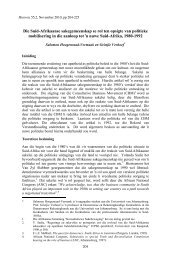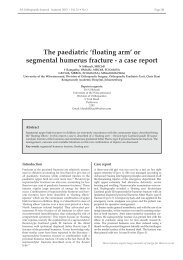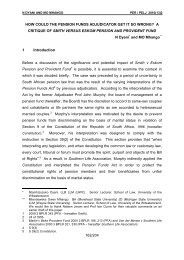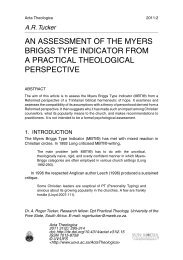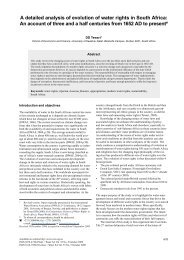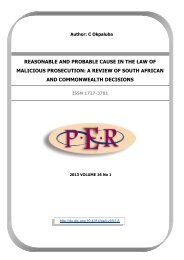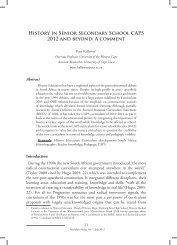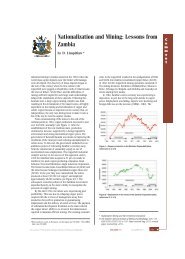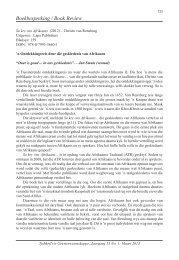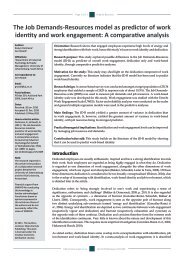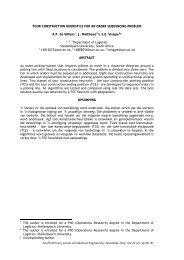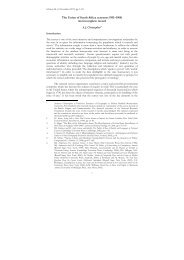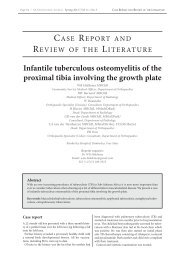An experimental study of non-Newtonian fluid flow in rectangular ...
An experimental study of non-Newtonian fluid flow in rectangular ...
An experimental study of non-Newtonian fluid flow in rectangular ...
You also want an ePaper? Increase the reach of your titles
YUMPU automatically turns print PDFs into web optimized ePapers that Google loves.
<strong>An</strong> <strong>experimental</strong> <strong>study</strong> <strong>of</strong><br />
<strong>non</strong>-<strong>Newtonian</strong> <strong>fluid</strong> <strong>flow</strong><br />
<strong>in</strong> <strong>rectangular</strong> flumes <strong>in</strong><br />
lam<strong>in</strong>ar, transition and<br />
turbulent <strong>flow</strong> regimes<br />
R Haldenwang, P T Slatter and R P Chhabra<br />
New and extensive results are reported on the <strong>flow</strong> <strong>of</strong> a range <strong>of</strong> <strong>non</strong>-<strong>Newtonian</strong> <strong>fluid</strong>s,<br />
<strong>in</strong>clud<strong>in</strong>g aqueous suspensions <strong>of</strong> bentonite and kaol<strong>in</strong>, and aqueous solutions <strong>of</strong> synthetic<br />
polymer carboxymethyl cellulose (CMC), <strong>flow</strong><strong>in</strong>g down <strong>in</strong>cl<strong>in</strong>ed flumes <strong>of</strong> <strong>rectangular</strong> crosssection<br />
<strong>of</strong> three different sizes. In particular, these tests elucidate the role <strong>of</strong> shear-th<strong>in</strong>n<strong>in</strong>g<br />
viscosity, with and without the presence <strong>of</strong> a yield stress, on the <strong>flow</strong> behaviour <strong>in</strong> flumes<br />
over a wide range <strong>of</strong> conditions <strong>of</strong> Reynolds numbers spann<strong>in</strong>g the range 1
Table 1 Test <strong>fluid</strong> characteristics<br />
Fluid ρ (kg/m 3 ) τ y (Pa) K(Pa.s n ) n<br />
3,0% kaol<strong>in</strong> suspension 1 050 1,73 0,004 0,955<br />
4,5% kaol<strong>in</strong> suspension 1 075 3,51 0,012 0,836<br />
5,3% kaol<strong>in</strong> suspension 1 088 4,99 0,030 0,717<br />
6,0% kaol<strong>in</strong> suspension 1 099 6,84 0,148 0,517<br />
8,0% kaol<strong>in</strong> suspension 1 118 9,34 0,208 0,539<br />
9,0% kaol<strong>in</strong> suspension 1 149 20,40 0,267 0,535<br />
10,0% kaol<strong>in</strong> suspension 1 165 21,30 0,524 0,468<br />
3,0% bentonite suspension 1 014 1,00 0,003 1<br />
4,5% bentonite suspension 1 025 4,40 0,006 1<br />
6,0% bentonite suspension 1 033 12,70 0,006 1<br />
1,0% CMC solution 1 007 – 0,060 0,655<br />
1,5% CMC solution 1 009 – 0,018 0,947<br />
1,8% CMC solution 1 011 – 0,087 0,765<br />
2,8% CMC solution 1 016 – 0,197 0,758<br />
3,8% CMC solution 1 021 – 0,606 0,678<br />
Currently available, limited literature <strong>in</strong><br />
the field can be conveniently divided <strong>in</strong>to<br />
three categories based on the motivation.<br />
Ow<strong>in</strong>g to the simplicity <strong>of</strong> the <strong>flow</strong> geometry,<br />
early studies were aimed at evaluat<strong>in</strong>g<br />
the rheological constants for a range <strong>of</strong><br />
materials by postulat<strong>in</strong>g the lam<strong>in</strong>ar <strong>flow</strong> to<br />
be one-dimensional, steady and uniform on<br />
an <strong>in</strong>cl<strong>in</strong>ed surface. Under these conditions,<br />
the shear stress varies l<strong>in</strong>early from a maximum<br />
value at the wall to zero at the free<br />
surface. Thus, one can parallel the analysis <strong>of</strong><br />
Rab<strong>in</strong>owitsch-Mooney for the <strong>flow</strong> <strong>in</strong> tubes<br />
to derive an expression for the shear rate at<br />
the wall from the <strong>flow</strong> depth–<strong>in</strong>cl<strong>in</strong>ation<br />
data, as outl<strong>in</strong>ed by Chhabra and Richardson<br />
(2008). The early work done by Astarita<br />
et al (1964) and Paslay and Slibar (1958)<br />
demonstrates the utility <strong>of</strong> this approach for<br />
power law and B<strong>in</strong>gham plastic model <strong>fluid</strong>s.<br />
Subsequently, this approach received further<br />
support from the <strong>experimental</strong> results<br />
reported by Therien et al (1970) and Sylvester<br />
et al (1973). Later this method was also<br />
shown to be applicable not only to the other<br />
<strong>non</strong>-<strong>Newtonian</strong> viscosity models (De Kee<br />
et al 1990; Coussot 1994, 1997), but also to<br />
the determ<strong>in</strong>ation <strong>of</strong> the yield stress without<br />
<strong>in</strong>vok<strong>in</strong>g a <strong>fluid</strong> model a priori (Uhlherr et al<br />
1984). In essence, the above studies treat this<br />
<strong>flow</strong> as viscometric and allude to the possibility<br />
<strong>of</strong> us<strong>in</strong>g the method as a viscometer,<br />
although many unresolved issues, such as<br />
the end-effects, the role <strong>of</strong> surface tension,<br />
etc, cont<strong>in</strong>ue to be some <strong>of</strong> the ma<strong>in</strong> impediments<br />
<strong>in</strong> this direction.<br />
The second category <strong>of</strong> studies has been<br />
motivated by eng<strong>in</strong>eer<strong>in</strong>g applications, such<br />
as estimat<strong>in</strong>g the dra<strong>in</strong>age <strong>of</strong> th<strong>in</strong> films<br />
adher<strong>in</strong>g to the walls <strong>of</strong> vessels <strong>in</strong> eng<strong>in</strong>eer<strong>in</strong>g<br />
applications. These studies attempt to<br />
develop frameworks for the prediction <strong>of</strong><br />
<strong>flow</strong> rate for a presupposed <strong>fluid</strong> model and<br />
a flume <strong>of</strong> known geometry. Of course, these<br />
two categories <strong>of</strong> <strong>study</strong> are not mutually<br />
exclusive. For <strong>in</strong>stance, Kozicki and Tiu<br />
(1967) were seem<strong>in</strong>gly the first to develop a<br />
general framework for the lam<strong>in</strong>ar <strong>flow</strong> <strong>of</strong><br />
time-<strong>in</strong>dependent <strong>non</strong>-<strong>Newtonian</strong> <strong>fluid</strong>s <strong>in</strong><br />
ducts <strong>of</strong> <strong>non</strong>-circular cross-section. Their<br />
approach leads to the usual friction factor–<br />
Reynolds number relationship. This method<br />
h<strong>in</strong>ges on the identification <strong>of</strong> two geometric<br />
parameters which are fixed for a given shape,<br />
and are assumed to be <strong>in</strong>dependent <strong>of</strong> <strong>fluid</strong><br />
behaviour. This approach has been tested<br />
extensively for the <strong>flow</strong> <strong>of</strong> <strong>in</strong>elastic <strong>non</strong>-<br />
<strong>Newtonian</strong> <strong>fluid</strong>s <strong>in</strong> ducts <strong>of</strong> square, <strong>rectangular</strong><br />
and triangular cross-sections over wide<br />
ranges <strong>of</strong> conditions, but not for the <strong>flow</strong> <strong>in</strong><br />
open channels, except for the recent work by<br />
Haldenwang et al (2002) and Haldenwang<br />
(2003). Naik (1983) reported extensive<br />
results on the <strong>flow</strong> <strong>of</strong> kaol<strong>in</strong> and sand slurries.<br />
However, not only did most <strong>of</strong> his data<br />
relate to turbulent <strong>flow</strong> conditions <strong>in</strong> open<br />
channels, but he did not perform adequate<br />
rheological characterisation <strong>of</strong> his test <strong>fluid</strong>s.<br />
Therefore, it is not at all possible to del<strong>in</strong>eate<br />
the role <strong>of</strong> <strong>non</strong>-<strong>Newtonian</strong> characteristics<br />
from his <strong>study</strong>. Wilson (1991) used heuristic<br />
arguments to extend to power law <strong>fluid</strong>s the<br />
approach used for the design <strong>of</strong> flumes to<br />
transport <strong>Newtonian</strong> <strong>fluid</strong>s. In an attempt<br />
to ga<strong>in</strong> physical <strong>in</strong>sights, Sanders et al (2002)<br />
measured velocity pr<strong>of</strong>iles <strong>in</strong> open channels<br />
for coarse particles be<strong>in</strong>g transported <strong>in</strong><br />
<strong>non</strong>-<strong>Newtonian</strong> slurries.<br />
All these studies are based on the<br />
assumption <strong>of</strong> uniform steady and onedimensional<br />
<strong>flow</strong>. The third category consists<br />
<strong>of</strong> the studies <strong>in</strong> which one or more <strong>of</strong><br />
these assumptions was relaxed. For <strong>in</strong>stance,<br />
<strong>non</strong>-uniform and steady <strong>flow</strong>s <strong>in</strong> long vessels<br />
were studied by Wilson and Taylor (1996)<br />
and Taylor and Wilson (1997). Similarly,<br />
unsteady <strong>flow</strong>s as encountered <strong>in</strong> the<br />
spread<strong>in</strong>g <strong>of</strong> lava, or the spread<strong>in</strong>g <strong>of</strong> a yield<br />
stress material dur<strong>in</strong>g the slump test, were<br />
<strong>in</strong>vestigated with<strong>in</strong> the framework <strong>of</strong> slow<br />
<strong>flow</strong> by Huang and Garcia (1998), Balmforth<br />
et al (2000), etc. The effect <strong>of</strong> f<strong>in</strong>ite channel<br />
width has been <strong>in</strong>vestigated by Mei and Yuhi<br />
(2001). Excellent survey articles summaris<strong>in</strong>g<br />
these and other studies are available <strong>in</strong> the<br />
literature (Balmforth et al 2007).<br />
From the above discussion it is clear that<br />
significant theoretical advances have been<br />
made <strong>in</strong> the field <strong>of</strong> <strong>non</strong>-<strong>Newtonian</strong> <strong>fluid</strong>s on<br />
<strong>in</strong>cl<strong>in</strong>ed surfaces. However, only very limited<br />
<strong>experimental</strong> results are available on the<br />
friction factor–Reynolds number relationship<br />
for the <strong>flow</strong> <strong>of</strong> such <strong>fluid</strong>s <strong>in</strong> open channels,<br />
although this relationship is <strong>of</strong> considerable<br />
importance for both theoretical and pragmatic<br />
reasons <strong>in</strong> numerous sett<strong>in</strong>gs. Nor has<br />
there been a systematic <strong>study</strong> on del<strong>in</strong>eat<strong>in</strong>g<br />
the end <strong>of</strong> lam<strong>in</strong>ar <strong>flow</strong> conditions and the<br />
onset <strong>of</strong> the turbulent <strong>flow</strong> regime for the<br />
<strong>flow</strong> <strong>of</strong> <strong>non</strong>-<strong>Newtonian</strong> <strong>fluid</strong>s <strong>in</strong> flumes.<br />
This work endeavours to fill these gaps <strong>in</strong> the<br />
current knowledge on this subject.<br />
EXPERIMENTAL MATERIALS<br />
AND PROCEDURE<br />
The test <strong>fluid</strong>s used <strong>in</strong> this <strong>study</strong> consisted <strong>of</strong><br />
aqueous suspensions <strong>of</strong> bentonite and kaol<strong>in</strong><br />
clays, and aqueous solutions <strong>of</strong> carboxymethyl<br />
cellulose polymer <strong>of</strong> various concentrations.<br />
The <strong>fluid</strong>s were prepared by gradually<br />
add<strong>in</strong>g the requisite amount <strong>of</strong> dry solids<br />
to the measured quantity <strong>of</strong> water, followed<br />
by gentle agitation. Over the concentration<br />
range and <strong>flow</strong> conditions used here, there<br />
was no detectable settl<strong>in</strong>g <strong>of</strong> the suspensions;<br />
the polymer solutions are known to be stable<br />
over a long period <strong>of</strong> time. All materials<br />
tested were thus treated as homogeneous<br />
cont<strong>in</strong>ua. The shear stress-shear rate behaviour<br />
<strong>of</strong> each test <strong>fluid</strong> was measured us<strong>in</strong>g<br />
pipel<strong>in</strong>e viscometers as described <strong>in</strong> the<br />
next section. Their densities were measured<br />
us<strong>in</strong>g a constant-volume density bottle. The<br />
physical characteristics <strong>of</strong> the test <strong>fluid</strong>s are<br />
summarised <strong>in</strong> Table 1. In all, 14 test <strong>fluid</strong>s<br />
were employed to encompass wide ranges<br />
<strong>of</strong> rheological characteristics and <strong>of</strong> the<br />
Reynolds number.<br />
12<br />
Journal <strong>of</strong> the South African Institution <strong>of</strong> Civil Eng<strong>in</strong>eer<strong>in</strong>g • Volume 52 Number 1 April 2010
Mix<strong>in</strong>g tank<br />
Weigh tank<br />
Progressive cavity<br />
Positive<br />
displacement<br />
pump<br />
Hydraulic ram<br />
Figure 1 Flume and tube viscometer<br />
Differential pressure transducers<br />
Heat exchanger<br />
Mag <strong>flow</strong><br />
meter<br />
Tube Viscometer<br />
Vernier depth gauges<br />
Flow via pipe viscometer<br />
Temperature<br />
probe<br />
13 mm<br />
28 mm<br />
80 mm<br />
Mass <strong>flow</strong><br />
Pressure tapp<strong>in</strong>gs meter<br />
Progressive cavity<br />
Positive displacement pump<br />
Flume<br />
Mix<strong>in</strong>g tank<br />
size flume, sets <strong>of</strong> <strong>flow</strong> data were collected<br />
for various concentrations, slopes and <strong>flow</strong><br />
rates, as well as tube viscometer data for<br />
each concentration.<br />
The flumes were connected by means<br />
<strong>of</strong> pipes to an <strong>in</strong>-l<strong>in</strong>e tube viscometer (with<br />
three tubes <strong>of</strong> different diameters, namely<br />
13, 28 and 80 mm), as shown schematically<br />
<strong>in</strong> Figure 1.<br />
Each tube was fitted with a magnetic <strong>flow</strong><br />
meter and differential pressure transducers<br />
to measure the pressure drop across a fixed<br />
straight length <strong>of</strong> the pipe. From these measurements,<br />
the nom<strong>in</strong>al shear rate (8V/D)<br />
and the average wall shear stress data can<br />
be calculated (Chhabra & Richardson 2008).<br />
The estimated uncerta<strong>in</strong>ty <strong>in</strong> wall shear<br />
stress is less than 5% and that <strong>in</strong> the nom<strong>in</strong>al<br />
shear rate less than 0,5% (Haldenwang 2003).<br />
These data were then used to evaluate the<br />
true shear stress–shear rate behaviour <strong>of</strong> the<br />
test <strong>fluid</strong>s used <strong>in</strong> this <strong>study</strong>.<br />
Shear stress (Pa)<br />
14<br />
12<br />
10<br />
8<br />
6<br />
4<br />
TREATMENT OF<br />
EXPERIMENTAL DATA<br />
Rheological behaviour <strong>of</strong> test <strong>fluid</strong>s<br />
Us<strong>in</strong>g the pressure drop–<strong>flow</strong> rate data<br />
obta<strong>in</strong>ed from the three pipe loops, it<br />
is customary to calculate the wall shear<br />
stress–nom<strong>in</strong>al shear rate at the pipe wall as<br />
follows:<br />
τ w = D 4 ⎛ ⎝ – Δp<br />
L ⎞ ⎠ (1)<br />
2<br />
0<br />
0<br />
200<br />
400<br />
600<br />
Figure 2 Flow curve for 6% kaol<strong>in</strong> suspension<br />
The flume tests were conducted <strong>in</strong> two<br />
tilt<strong>in</strong>g flumes, one 10 m long by 300 mm<br />
wide, and the other 5 m long by 75 mm<br />
wide, both <strong>of</strong> which can be tilted up to 5 o<br />
from the horizontal. The 300 mm-wide<br />
flume can be longitud<strong>in</strong>ally partitioned to<br />
a width <strong>of</strong> 150 mm. The <strong>flow</strong> was provided<br />
by a 100 mm progressive cavity, positivedisplacement<br />
pump or a Warman 4 x 3<br />
centrifugal slurry pump, depend<strong>in</strong>g on the<br />
desired <strong>flow</strong> rate. The maximum <strong>flow</strong> rate<br />
achieved <strong>in</strong> this <strong>study</strong> was 45 litres per<br />
second.<br />
Flow depths were measured with digital<br />
depth gauges fitted at distances <strong>of</strong> 5 and 6 m<br />
downstream <strong>of</strong> the <strong>in</strong>let <strong>of</strong> the 10 m flume.<br />
These distances were found to be adequate<br />
800<br />
Shear rate (s –1 )<br />
1 000<br />
1 200<br />
1 400<br />
1 600<br />
to ensure that the entrance and exit effects<br />
would be negligible (Haldenwang 2003).<br />
The difference between the values <strong>of</strong> the<br />
<strong>fluid</strong> depth between these two locations was<br />
found to be ±5% and therefore the <strong>flow</strong> depth<br />
was assumed to be uniform.<br />
The flume tests consisted <strong>of</strong> measur<strong>in</strong>g<br />
the <strong>flow</strong> rate with magnetic <strong>flow</strong> meters<br />
and the <strong>flow</strong> depth with digital depth<br />
gauges, for various channel slopes from 1°<br />
to 5°. All the <strong>in</strong>struments were l<strong>in</strong>ked to a<br />
PC via a data-logger. The calibrated data<br />
<strong>in</strong>puts were recorded and computationally<br />
reduced to values <strong>of</strong> Reynolds number<br />
and friction factor, and then plotted as a<br />
Moody diagram. This enabled deviations<br />
to be observed <strong>in</strong>stantaneously. For each<br />
γ˙wn = 8V (2)<br />
D<br />
The true shear rate at the wall is given by<br />
apply<strong>in</strong>g the Rab<strong>in</strong>owitsch-Mooney correction<br />
factor to the nom<strong>in</strong>al shear rate given by<br />
Eq (2) as follows (see Chhabra & Richardson<br />
2008 for details):<br />
γ˙w = ⎛ 3n' + 1<br />
⎝<br />
⎞<br />
⎠ ⎛ ⎝ 8V ⎞ D ⎠ = ⎛ 3n' + 1<br />
⎝<br />
⎞<br />
⎠<br />
where<br />
4n'<br />
n' = d ln τ w<br />
d ln⎛ ⎝<br />
8V<br />
D ⎞ ⎠<br />
4n'<br />
γ˙wn (3)<br />
which is evaluated at the pert<strong>in</strong>ent value <strong>of</strong><br />
the nom<strong>in</strong>al wall shear stress. Figure 2 shows<br />
typical shear stress–shear rate behaviour<br />
for a 6% kaol<strong>in</strong> suspension. The fact that<br />
the results for the different pipe diameters<br />
collapse onto a s<strong>in</strong>gle curve is evidence that<br />
these data are free from slip and end-effects<br />
(Chhabra & Richardson 2008). Similar<br />
results were obta<strong>in</strong>ed for the other test <strong>fluid</strong>s<br />
used <strong>in</strong> this work, but for the sake <strong>of</strong> brevity<br />
they are not <strong>in</strong>cluded here.<br />
Journal <strong>of</strong> the South African Institution <strong>of</strong> Civil Eng<strong>in</strong>eer<strong>in</strong>g • Volume 52 Number 1 April 2010 13
f-Friction factor<br />
100<br />
10<br />
1<br />
0,1<br />
0,01<br />
τ w = ρgH s<strong>in</strong> θ (5)<br />
where H is the uniform <strong>flow</strong> depth.<br />
As the H/w values <strong>in</strong> lam<strong>in</strong>ar <strong>flow</strong> were<br />
<strong>in</strong> many <strong>in</strong>stances > 0,1, the hydraulic diameter<br />
was used, with the average wall shear<br />
stress for the open channel be<strong>in</strong>g given as<br />
(Sanders et al 2002):<br />
τ w = ρgD h s<strong>in</strong> θ (6)<br />
A convenient <strong>non</strong>-dimensional shear stress<br />
is written <strong>in</strong> terms <strong>of</strong> the Fann<strong>in</strong>g friction<br />
factor (f ) as follows:<br />
0,001<br />
0,1 1<br />
Figure 3 Typical Moody diagram for 300 mm flume with 3 different <strong>fluid</strong>s<br />
10<br />
8% kaol<strong>in</strong> 3,8% CMC 4,5% bentonite 16/Re l<strong>in</strong>e<br />
100<br />
Re-Reynolds number<br />
1 000<br />
10 000<br />
f =<br />
τ w (7)<br />
⎛<br />
⎝ 1 2 ⎞ ⎠ V2 ρ<br />
The other pert<strong>in</strong>ent dimensionless parameter<br />
is, <strong>of</strong> course, the Reynolds number,<br />
Re. For <strong>Newtonian</strong> <strong>fluid</strong>s, one can def<strong>in</strong>e<br />
the Reynolds number <strong>in</strong> an unambiguous<br />
manner as:<br />
1 degree slope<br />
3 degree slope<br />
Re = ρVL c<br />
μ<br />
(8)<br />
Reynolds number (log scale)<br />
Lam<strong>in</strong>ar region<br />
(power law relationship)<br />
Figure 4 Reynolds number aga<strong>in</strong>st Froude number (typical <strong>experimental</strong> behaviour)<br />
Once the true shear stress–shear rate<br />
data are available, it is customary to fit a<br />
rheological model to these. In view <strong>of</strong> the<br />
fact that all the test <strong>fluid</strong>s used <strong>in</strong> this work<br />
displayed shear-th<strong>in</strong>n<strong>in</strong>g behaviour, and that<br />
the kaol<strong>in</strong> and bentonite suspensions also<br />
displayed the presence <strong>of</strong> a yield stress, the<br />
Herschel-Bulkley rheological model was used<br />
here which, <strong>in</strong> simple shear, is written as:<br />
τ = τ y + Kγ˙n (4)<br />
Eq (4) <strong>in</strong>cludes the <strong>Newtonian</strong> (n = 1; τ y = 0),<br />
B<strong>in</strong>gham plastic (n = 1) and power-law<br />
(τ y = 0) <strong>fluid</strong> models as limit<strong>in</strong>g cases, and<br />
it is thus extremely versatile <strong>in</strong> captur<strong>in</strong>g a<br />
range <strong>of</strong> <strong>non</strong>-<strong>Newtonian</strong> characteristics.<br />
A<br />
Froude number (l<strong>in</strong>ear scale)<br />
Full turbulence<br />
Onset <strong>of</strong> transition<br />
The best-fit values <strong>of</strong> τ y , K and n were<br />
found by perform<strong>in</strong>g <strong>non</strong>-l<strong>in</strong>ear regression<br />
on the shear stress–shear rate data for each<br />
<strong>fluid</strong>. The error analysis performed <strong>in</strong>dicated<br />
that the accuracies <strong>of</strong> τ y , K and n were <strong>in</strong><br />
the region <strong>of</strong> 2, 7 and 3% respectively. The<br />
result<strong>in</strong>g values <strong>of</strong> these constants are also<br />
summarised <strong>in</strong> Table 1.<br />
Flume data (<strong>flow</strong> rate-<strong>in</strong>cl<strong>in</strong>ation)<br />
It is also customary to convert the <strong>flow</strong><br />
rate–<strong>in</strong>cl<strong>in</strong>ation data for a given <strong>fluid</strong> <strong>in</strong>to<br />
dimensionless form. When (H/w) < 0,1, it is<br />
perhaps reasonable to postulate that the <strong>flow</strong><br />
is one-dimensional and the end-effects are<br />
negligible. Under these conditions the shear<br />
stress at the wall is given by:<br />
A<br />
where the characteristic l<strong>in</strong>ear dimension L c<br />
is usually taken as the hydraulic diameter D h<br />
for <strong>non</strong>-circular cross-sections. For H/w
Apparent viscosity (Pa.s)<br />
Figure 5 Apparent viscosity aga<strong>in</strong>st shear rate for 6% kaol<strong>in</strong>, 6% bentonite and 2,8% CMC and water<br />
Shear stress (Pa)<br />
Fr = V<br />
√gH<br />
0,1<br />
0,01<br />
0,001<br />
0,0001<br />
1 10<br />
100<br />
10<br />
10<br />
1<br />
1<br />
0,1<br />
0,1 1<br />
(10)<br />
Depend<strong>in</strong>g on the value <strong>of</strong> the Froude number,<br />
the <strong>flow</strong> is classed as sub-critical (Fr < 1) or<br />
super-critical (Fr > 1); the former is dom<strong>in</strong>ated<br />
by gravity while the <strong>in</strong>ertial forces dom<strong>in</strong>ate the<br />
latter. The <strong>flow</strong> is said to be critical at Fr = 1.<br />
Thus, <strong>in</strong> summary, the <strong>flow</strong> <strong>of</strong> <strong>non</strong>-<br />
<strong>Newtonian</strong> <strong>fluid</strong>s <strong>in</strong> an open channel can be<br />
described <strong>in</strong> terms <strong>of</strong> the three dimensionless<br />
parameters: f, Re, and Fr. This relationship<br />
is explored <strong>in</strong> the next section.<br />
It should be borne <strong>in</strong> m<strong>in</strong>d that for the<br />
<strong>flow</strong> <strong>of</strong> <strong>Newtonian</strong> <strong>fluid</strong>s <strong>in</strong> circular pipes,<br />
the use <strong>of</strong> the f-Re coord<strong>in</strong>ates leads to the<br />
well-known Moody diagram which shows<br />
100<br />
Shear rate (s –1 )<br />
1 000<br />
6% Kaol<strong>in</strong> 6% Bentonite 2,8% CMC Water<br />
B<strong>in</strong>gham <strong>fluid</strong><br />
Yield pseudoplastic <strong>fluid</strong><br />
Pseudoplastic <strong>fluid</strong><br />
Figure 6 Rheogram for 6% kaol<strong>in</strong>, 6% bentonite and 2,8% CMC<br />
A<br />
10<br />
100<br />
Shear rate (s –1 )<br />
A<br />
1 000<br />
6% Kaol<strong>in</strong> 6% Bentonite 2,8% CMC<br />
10 000<br />
10 000<br />
a dist<strong>in</strong>ct signature correspond<strong>in</strong>g to the<br />
cessation <strong>of</strong> lam<strong>in</strong>ar <strong>flow</strong> conditions at<br />
Re = 2 100, i.e. the values <strong>of</strong> the friction<br />
factor beg<strong>in</strong> to deviate from the expected<br />
lam<strong>in</strong>ar <strong>flow</strong> characteristics given by:<br />
f = 16<br />
(11)<br />
Re<br />
Although the lam<strong>in</strong>ar <strong>flow</strong> conditions cease<br />
to exist at Re~2 100, the fully turbulent<br />
regime is preceded by a transition zone.<br />
Needless to say, the friction factors <strong>in</strong> the<br />
transition and turbulent regions have been<br />
correlated empirically by numerous equations<br />
<strong>of</strong> vary<strong>in</strong>g forms and complexity. Beyond<br />
the lam<strong>in</strong>ar <strong>flow</strong> regime, the value <strong>of</strong> the<br />
friction factor is also <strong>in</strong>fluenced by the pipe<br />
wall roughness. This approach has also been<br />
extended to power law and visco-plastic <strong>fluid</strong>s<br />
<strong>in</strong> circular tubes and pipes, albeit not as successfully<br />
as with the Moody diagram (Govier<br />
& Aziz 1977). In view <strong>of</strong> the simplicity <strong>of</strong> this<br />
approach, it is natural to explore the possibility<br />
<strong>of</strong> extend<strong>in</strong>g it to <strong>flow</strong> <strong>in</strong> open channels, as<br />
demonstrated <strong>in</strong> the next section.<br />
RESULTS AND DISCUSSION<br />
At the outset, the results were plotted us<strong>in</strong>g<br />
f-Re (given by Eq (9)) coord<strong>in</strong>ates. Figure 3<br />
shows a representative sample <strong>of</strong> the friction<br />
factor–Reynolds number relationship for<br />
three different <strong>fluid</strong>s <strong>in</strong> the 300 mm-wide<br />
flume. Similar results were obta<strong>in</strong>ed for the<br />
other <strong>fluid</strong>s and/or flume <strong>in</strong>cl<strong>in</strong>ations, but<br />
are not <strong>in</strong>cluded here to avoid clutter<strong>in</strong>g the<br />
figures due to the numerous overlapp<strong>in</strong>g data<br />
po<strong>in</strong>ts. Clearly, the def<strong>in</strong>ition <strong>of</strong> the Reynolds<br />
number given by Eq (9) does confirm the<br />
validity <strong>of</strong> Eq (11) for the <strong>flow</strong> <strong>of</strong> time<strong>in</strong>dependent<br />
<strong>non</strong>-<strong>Newtonian</strong> <strong>fluid</strong>s <strong>in</strong> open<br />
channels as well.<br />
Though there is considerable confusion<br />
<strong>in</strong> the literature regard<strong>in</strong>g the turbulent<br />
<strong>flow</strong> <strong>of</strong> <strong>non</strong>-<strong>Newtonian</strong> <strong>fluid</strong>s even <strong>in</strong> pipes,<br />
Slatter (1996) developed the follow<strong>in</strong>g semiempirical<br />
form <strong>of</strong> the velocity pr<strong>of</strong>ile <strong>in</strong> a<br />
pipe under turbulent conditions.<br />
V<br />
V *<br />
= 1 χ ln ⎛ ⎝<br />
R<br />
d 85<br />
⎞ ⎠<br />
+ B – 3,75 (12)<br />
This will also be used here to analyse the<br />
present results for open channel <strong>flow</strong>.<br />
However, what is less obvious <strong>in</strong> this approach<br />
is the critical value <strong>of</strong> the Reynolds number<br />
denot<strong>in</strong>g the limit <strong>of</strong> lam<strong>in</strong>ar <strong>flow</strong> conditions,<br />
ak<strong>in</strong> to that observed <strong>in</strong> circular pipes.<br />
Intuitively, one would expect the role<br />
<strong>of</strong> the Froude number to be much more<br />
significant here than that <strong>in</strong> the lam<strong>in</strong>ar <strong>flow</strong><br />
regime.<br />
The plots <strong>of</strong> Reynolds number aga<strong>in</strong>st<br />
Froude number revealed a characteristic<br />
shape, which dist<strong>in</strong>ctly <strong>in</strong>dicated a change<br />
<strong>of</strong> gradient effect correspond<strong>in</strong>g to the end<br />
<strong>of</strong> the lam<strong>in</strong>ar <strong>flow</strong> regime, as shown <strong>in</strong><br />
Figure 4.<br />
The onset <strong>of</strong> fully turbulent conditions<br />
manifested <strong>in</strong> terms <strong>of</strong> another dist<strong>in</strong>ct<br />
change <strong>in</strong> shape <strong>of</strong> the Re-Fr map. This form<br />
<strong>of</strong> behaviour was observed for all data sets.<br />
Evidently, what would be <strong>of</strong> great practical<br />
utility is to l<strong>in</strong>k these transition po<strong>in</strong>ts<br />
(seen as a change <strong>of</strong> gradients and shown as<br />
<strong>in</strong>flection po<strong>in</strong>ts A on Figure 4) to the measurable<br />
rheological properties <strong>of</strong> the test <strong>fluid</strong>s.<br />
This l<strong>in</strong>k was established <strong>in</strong> an empirical<br />
manner by exam<strong>in</strong><strong>in</strong>g the apparent viscosity<br />
values at a range <strong>of</strong> shear rates (50, 100, 200<br />
and 500 s -1 ). It is worthwhile to emphasise<br />
Journal <strong>of</strong> the South African Institution <strong>of</strong> Civil Eng<strong>in</strong>eer<strong>in</strong>g • Volume 52 Number 1 April 2010 15
Re-Reynolds number<br />
Figure 7 Empirical behaviour <strong>of</strong> 2,8% CMC <strong>in</strong> 150 mm flume<br />
Re-Reynolds number<br />
10 000<br />
1 000<br />
100<br />
10<br />
10 000<br />
1 000<br />
100<br />
10<br />
1<br />
0 0,5<br />
Lam<strong>in</strong>ar <strong>flow</strong><br />
here that the viscous effects are only <strong>of</strong><br />
secondary importance <strong>in</strong> the turbulent <strong>flow</strong><br />
regime (Slatter 1999).<br />
Figure 5 shows apparent viscosity aga<strong>in</strong>st<br />
shear rate for 6% bentonite, 6% kaol<strong>in</strong> and<br />
2,8% polymer carboxymethyl cellulose<br />
(CMC) and it can be clearly observed that<br />
the apparent viscosity <strong>of</strong> these <strong>fluid</strong>s is very<br />
similar at a shear rate <strong>of</strong> 100 s -1 . One would<br />
expect the correspond<strong>in</strong>g values <strong>of</strong> shear<br />
stress to be similar, as seen <strong>in</strong> Figure 6.<br />
Detailed analysis <strong>of</strong> the <strong>experimental</strong> data<br />
revealed that γ˙=100s –1 is probably a representative<br />
shear rate <strong>of</strong> the transition po<strong>in</strong>t,<br />
although it is difficult to <strong>of</strong>fer any theoretical<br />
justification for this assertion and it is<br />
entirely an empirical observation.<br />
Onset <strong>of</strong> 'full turbulence'<br />
2 degrees<br />
y=292,9x 1,9978<br />
1,0<br />
1,5<br />
Fr-Froude number<br />
2 Degrees 2 Degrees lam<strong>in</strong>ar <strong>flow</strong><br />
1°<br />
y = 89,321x 2,299 5°<br />
y = 701,76x 2,0317<br />
4°<br />
y = 300,84x 2,1448<br />
3°<br />
y = 179,58x 2,216<br />
2°<br />
y = 133,25x 2,1212<br />
0 1,0<br />
2,0<br />
1°<br />
5°<br />
3° lam<strong>in</strong>ar <strong>flow</strong><br />
3,0<br />
Fr-Froude number<br />
2°<br />
5° lam<strong>in</strong>ar <strong>flow</strong><br />
4° lam<strong>in</strong>ar <strong>flow</strong><br />
Figure 8 Onset <strong>of</strong> transition locus for 4,6% bentonite <strong>in</strong> 150 mm flume<br />
Onset <strong>of</strong> transition<br />
4,0<br />
3°<br />
1° lam<strong>in</strong>ar <strong>flow</strong><br />
Transition locus<br />
2,0<br />
transition locus<br />
y = 613,32x + 440,37<br />
5,0<br />
4°<br />
2° lam<strong>in</strong>ar <strong>flow</strong><br />
2,5<br />
6,0<br />
The next step was to establish a relationship<br />
between the apparent viscosities <strong>of</strong> a<br />
specific slurry and the Froude number as<br />
observed from the plot <strong>of</strong> Reynolds number<br />
and Froude number for each slope. Based on<br />
the <strong>flow</strong> behaviour, the start <strong>of</strong> transition<br />
was deemed to be the po<strong>in</strong>t <strong>of</strong> <strong>in</strong>flection,<br />
as this po<strong>in</strong>t corresponds <strong>in</strong> all cases to the<br />
deviation from the 16/Re l<strong>in</strong>e on the Moody<br />
diagram. This is shown <strong>in</strong> Figure 7 which<br />
portrays typical behaviour. Furthermore,<br />
the onset <strong>of</strong> full turbulence was held to<br />
occur at a po<strong>in</strong>t where the Froude number<br />
atta<strong>in</strong>s the maximum value <strong>of</strong> these plots <strong>in</strong><br />
each case. The transition regime therefore<br />
occupies the region between these two<br />
po<strong>in</strong>ts.<br />
Onset <strong>of</strong> transition<br />
The po<strong>in</strong>ts <strong>of</strong> <strong>in</strong>flection were connected<br />
and the l<strong>in</strong>ear relationship was established<br />
between these po<strong>in</strong>ts to establish a transition<br />
locus for a given <strong>fluid</strong>, as shown <strong>in</strong><br />
Figure 8. This was done for all the data<br />
sets. Thereafter the gradient and ord<strong>in</strong>ate<strong>in</strong>tercept<br />
for each relationship was plotted<br />
aga<strong>in</strong>st the apparent viscosities at shear rates<br />
<strong>of</strong> 50, 100 and 200 s -1 .<br />
These shear rates were chosen on the<br />
basis <strong>of</strong> a detailed analysis <strong>of</strong> the <strong>experimental</strong><br />
data as it was reasoned that the onset <strong>of</strong><br />
transition would usually occur <strong>in</strong> the lower<br />
shear rate region. The apparent viscosity at a<br />
shear rate <strong>of</strong> 100 s -1 yielded the best results.<br />
From this a trend was established<br />
between the gradient (M) and the ord<strong>in</strong>ate<strong>in</strong>tercept<br />
(C) values, with the apparent<br />
viscosities at the shear rate <strong>of</strong> 100 s -1 .<br />
The relationship between M and the<br />
apparent viscosity at 100 s -1 is best approximated<br />
as follows:<br />
M = 853,1⎛ ⎝<br />
μ/ γ˙=100s<br />
–1<br />
μ w<br />
⎞ ⎠<br />
–0,21<br />
(13)<br />
The relationship between C and the apparent<br />
viscosity at 100 s -1 is as follows:<br />
C = 1,263x10 4⎛ ⎝ μ/ γ˙=100s –1<br />
μ w<br />
⎞ ⎠<br />
–0,75<br />
(14)<br />
The value <strong>of</strong> the critical Reynolds number at<br />
the onset <strong>of</strong> transition is:<br />
Re c = 853,1⎛ ⎝<br />
μ/ γ˙=100s<br />
–1<br />
μ w<br />
⎞ ⎠<br />
–0,21 Fr + 1,263x10 4⎛ ⎝<br />
μ/ γ˙=100s<br />
–1<br />
μ w<br />
⎞ ⎠<br />
–0,75<br />
(15)<br />
where μ w is the viscosity <strong>of</strong> water taken as<br />
10 -3 Pa.s.<br />
The critical Reynolds number does not<br />
have a s<strong>in</strong>gle value, but is a relationship<br />
between Reynolds number and Froude<br />
number for the specific apparent viscosity.<br />
The position <strong>of</strong> the onset <strong>of</strong> transition is<br />
given by the <strong>in</strong>tersection po<strong>in</strong>t <strong>of</strong> the equation<br />
(Eq 15) and the lam<strong>in</strong>ar <strong>flow</strong> equation,<br />
i.e. f = 16/Re. This is an iterative process to<br />
obta<strong>in</strong> the value <strong>of</strong> the <strong>flow</strong> such that both<br />
these equations are satisfied simultaneously.<br />
Onset <strong>of</strong> turbulence<br />
The approach used above to locate the end<br />
<strong>of</strong> the lam<strong>in</strong>ar <strong>flow</strong> regime was paralleled to<br />
del<strong>in</strong>eate the onset <strong>of</strong> turbulent conditions,<br />
reflected as another change <strong>in</strong> gradient <strong>in</strong><br />
the Re-Fr plot, as shown <strong>in</strong> Figure 9. This<br />
corresponds to the maximum value <strong>of</strong> the<br />
Froude number. The po<strong>in</strong>ts where the Froude<br />
number was at a maximum were connected<br />
and a l<strong>in</strong>ear relationship was determ<strong>in</strong>ed.<br />
From this a trend was established<br />
between the M and C values, and the apparent<br />
viscosity.<br />
16<br />
Journal <strong>of</strong> the South African Institution <strong>of</strong> Civil Eng<strong>in</strong>eer<strong>in</strong>g • Volume 52 Number 1 April 2010
Re-Reynolds number<br />
Figure 9 Onset <strong>of</strong> “full turbulence” 4,5% kaol<strong>in</strong> <strong>in</strong> 150 mm flume<br />
f-Friction factor<br />
100 000<br />
10 000<br />
1 000<br />
100<br />
10<br />
10<br />
1<br />
0,1<br />
0,01<br />
0 1,0<br />
2,0<br />
5°<br />
1°<br />
4° lam<strong>in</strong>ar <strong>flow</strong><br />
Full turbulence locus<br />
y = 764,78x + 2 788,1<br />
y = 2,1177 y =<br />
1°<br />
637,6x<br />
3°<br />
y = 141,2x 2,1292 5°<br />
y = 81,585x 2,3697<br />
201,27x 2,0738 4°<br />
2°<br />
y = 295,62x 2,1319<br />
3,0<br />
Fr-Froude number<br />
4°<br />
2° lam<strong>in</strong>ar <strong>flow</strong><br />
5° lam<strong>in</strong>ar <strong>flow</strong><br />
4,0<br />
5,0<br />
3°<br />
2°<br />
1° lam<strong>in</strong>ar <strong>flow</strong> 3° lam<strong>in</strong>ar <strong>flow</strong><br />
Full turbulence locus<br />
6,0<br />
■<br />
■<br />
■<br />
■<br />
In lam<strong>in</strong>ar <strong>flow</strong> conditions, the present<br />
extensive data for a range <strong>of</strong> <strong>fluid</strong>s conform<br />
to the expected behaviour, namely,<br />
f = 16/Re.<br />
At low concentrations (< 3% for bentonite,<br />
< 5% for kaol<strong>in</strong> and < 2% for CMC),<br />
a sudden <strong>in</strong>crease <strong>in</strong> the value <strong>of</strong> the<br />
friction factor <strong>in</strong> the transition regime<br />
<strong>of</strong> Re = 2 000 to 8 000 was observed –<br />
similar to that <strong>of</strong> water – a sudden jump<br />
<strong>in</strong> a very unstable region. This sudden<br />
<strong>in</strong>crease was very difficult to measure<br />
and characterise due to the <strong>in</strong>herently<br />
fluctuat<strong>in</strong>g and unstable nature <strong>of</strong> the<br />
<strong>flow</strong> under these conditions. With<br />
<strong>in</strong>creas<strong>in</strong>g <strong>flow</strong> rate, the free surface<br />
became <strong>in</strong>creas<strong>in</strong>gly irregular, and a<br />
po<strong>in</strong>t was reached where the <strong>flow</strong> height<br />
was measured on top <strong>of</strong> the irregularities<br />
which manifested as the sudden <strong>in</strong>crease<br />
<strong>in</strong> friction factor to full turbulence. The<br />
more viscous the <strong>fluid</strong>, the smoother the<br />
transition region, and the lower was the<br />
critical Reynolds number where the data<br />
began to deviate from the lam<strong>in</strong>ar 16/Re<br />
l<strong>in</strong>e.<br />
It appears from <strong>experimental</strong> evidence<br />
that the critical Reynolds number cannot<br />
be fixed to a classically narrow region as<br />
<strong>in</strong> the case <strong>of</strong> a pipe, but occurs over a<br />
much wider range <strong>of</strong> Reynolds numbers,<br />
depend<strong>in</strong>g on the viscous characteristics<br />
<strong>of</strong> the <strong>fluid</strong>.<br />
This trend was consistent for three very<br />
different rheologically classified <strong>fluid</strong>s,<br />
namely bentonite, kaol<strong>in</strong> and CMC.<br />
0,001<br />
10<br />
Turbulence model<br />
Actual data<br />
The best relationship was for the apparent<br />
viscosity at a shear rate <strong>of</strong> 500 s -1 .<br />
The value <strong>of</strong> the critical Reynolds number<br />
at the onset <strong>of</strong> “full turbulence” or the end <strong>of</strong><br />
transition is:<br />
100<br />
1 000<br />
Re-Reynolds number<br />
Lam<strong>in</strong>ar <strong>flow</strong> model<br />
Power (Transition)<br />
Figure 10 Moody diagram <strong>of</strong> 6% bentonite <strong>in</strong> 150 mm flume with 4° slope<br />
Transition<br />
10 000<br />
modified by <strong>in</strong>corporat<strong>in</strong>g the apparent viscosity<br />
at a shear rate <strong>of</strong> 500 s -1 to be consistent<br />
with the above phenomenological considerations<br />
(Haldenwang 2003). This leads to the<br />
follow<strong>in</strong>g expression for average velocity:<br />
ILLUSTRATIVE EXAMPLES<br />
We conclude by demonstrat<strong>in</strong>g the utility<br />
<strong>of</strong> the scheme presented <strong>in</strong> this paper.<br />
Two examples <strong>in</strong> which this procedure was<br />
validated us<strong>in</strong>g the <strong>experimental</strong> data are<br />
presented <strong>in</strong> Figures 10 and 11. In Figure 10,<br />
10% kaol<strong>in</strong> <strong>in</strong> a 150 mm flume at a slope <strong>of</strong><br />
5 o is shown. Figure 11 depicts 1,5% CMC <strong>in</strong> a<br />
300 mm flume at a 1 o slope.<br />
These examples are presented to show<br />
that the <strong>flow</strong> for the materials tested can be<br />
predicted reasonably well over a range <strong>of</strong><br />
<strong>flow</strong> conditions.<br />
Re c(turb) =<br />
3812<br />
⎛<br />
⎝ μ/ γ˙=500s –1 0,52<br />
⎞<br />
μ ⎠<br />
w<br />
Fr +<br />
9626<br />
⎛<br />
⎝ μ/ γ˙=500s –1 0,65<br />
⎞<br />
μ ⎠<br />
w (16)<br />
This critical Reynolds number aga<strong>in</strong> does<br />
not have a s<strong>in</strong>gle value, but is a relationship<br />
between Reynolds number and Froude<br />
number for the specific apparent viscosity.<br />
The position <strong>of</strong> the onset <strong>of</strong> transition is<br />
where the Re c(turb) (Eq 16) <strong>in</strong>tersects with<br />
the turbulent <strong>flow</strong> equation (Eq 12), slightly<br />
.<br />
V turb = √gHs<strong>in</strong> α ⎛ ⎝<br />
2,5ln 2R h<br />
k<br />
μ/<br />
– 76860⎛ γ˙=100s<br />
–1<br />
⎝<br />
⎞<br />
μ ⎠<br />
– 9,45⎞ ⎠<br />
(17)<br />
w<br />
Thus the critical Reynolds number denot<strong>in</strong>g<br />
the onset <strong>of</strong> turbulent <strong>flow</strong> is obta<strong>in</strong>ed by<br />
simultaneously solv<strong>in</strong>g Eq (16) and Eq (17).<br />
Lastly, based on the above analysis<br />
together with the detailed <strong>in</strong>spection <strong>of</strong> the<br />
extensive database, it is worth reiterat<strong>in</strong>g the<br />
follow<strong>in</strong>g overall trends:<br />
CONCLUSIONS<br />
This work has shown that it is possible to<br />
plot all the data from the flume tests on the<br />
standard Moody diagram us<strong>in</strong>g the Reynolds<br />
number, as suggested by Haldenwang et al<br />
(2002). Unlike the case <strong>of</strong> water <strong>flow</strong><strong>in</strong>g <strong>in</strong><br />
open channels, where ma<strong>in</strong>ly turbulent <strong>flow</strong><br />
occurs, when the <strong>fluid</strong> becomes more viscous<br />
and <strong>non</strong>-<strong>Newtonian</strong>, it is much more probable<br />
that lam<strong>in</strong>ar <strong>flow</strong> will be encountered.<br />
Journal <strong>of</strong> the South African Institution <strong>of</strong> Civil Eng<strong>in</strong>eer<strong>in</strong>g • Volume 52 Number 1 April 2010 17
γ˙w true shear rate at wall s -1<br />
shear rate s -1<br />
1,000<br />
m γ˙<br />
through open channels. Canadian Journal <strong>of</strong><br />
γ˙wn nom<strong>in</strong>al shear rate at wall s -1<br />
ρ density kg/m 3<br />
τ shear stress Pa<br />
0,100<br />
τ w wall shear stress Pa<br />
τ y yield stress Pa<br />
χ<br />
Von Karman constant<br />
0,010<br />
REFERENCES<br />
Astarita, G, Marrucci, G & Palumba, G 1964. Non-<br />
<strong>Newtonian</strong> <strong>flow</strong> along <strong>in</strong>cl<strong>in</strong>ed plane surfaces.<br />
Re-Reynolds number<br />
0,001<br />
100<br />
1 000<br />
10 000<br />
100 000<br />
Industrial & Eng<strong>in</strong>eer<strong>in</strong>g Chemistry Fundamentals,<br />
3(4): 333–339.<br />
Turbulence model<br />
Actual data<br />
Lam<strong>in</strong>ar <strong>flow</strong> model<br />
Power (Transition range)<br />
Transition range<br />
Balmforth, N, Burbridge, A & Craster, R 2000.<br />
Viscoplastic models <strong>of</strong> isothermal lava domes.<br />
Journal <strong>of</strong> Fluid Mechanics, 403: 37–65.<br />
Figure 11 Moody diagram <strong>of</strong> 1,5% CMC <strong>in</strong> 300 mm flume with 1° slope<br />
Balmforth, N, Craster, R, Rust, A & Sassi, R 2007:<br />
Viscoplastic <strong>flow</strong> over an <strong>in</strong>cl<strong>in</strong>ed surface. Journal <strong>of</strong><br />
Therefore it is important to determ<strong>in</strong>e the<br />
Non-<strong>Newtonian</strong> Fluid Mechanics, 142: 219–243.<br />
ƒ<br />
Fann<strong>in</strong>g friction factor<br />
<strong>flow</strong> regime for a given set <strong>of</strong> conditions.<br />
Coussot, P 1994. Steady lam<strong>in</strong>ar <strong>flow</strong> <strong>of</strong> concentrated<br />
While the analysis <strong>of</strong> the lam<strong>in</strong>ar <strong>flow</strong><br />
regime h<strong>in</strong>ges on sound physical considerations,<br />
the treatment <strong>of</strong> the transitional and<br />
turbulent <strong>flow</strong> regimes is <strong>of</strong> necessity empirical<br />
<strong>in</strong> nature. The scheme developed here<br />
Fr<br />
g<br />
H<br />
K<br />
Froude number<br />
gravitational acceleration<br />
height <strong>of</strong> <strong>fluid</strong> <strong>in</strong> flume<br />
<strong>fluid</strong> consistency <strong>in</strong>dex<br />
m/s 2<br />
m<br />
Pa.s n<br />
mud suspensions <strong>in</strong> open channels. Journal <strong>of</strong><br />
Hydraulic Research, 32: 535–558.<br />
Coussot, P 1997. Mud<strong>flow</strong> Rheology and Dynamics.<br />
Rotterdam: Balkema.<br />
Chadwick, A & Morfett, J 1999. Hydraulics <strong>in</strong> Civil and<br />
has been validated with <strong>experimental</strong> data<br />
Environmental Eng<strong>in</strong>eer<strong>in</strong>g. London: E & FN Spon.<br />
length between pressure<br />
obta<strong>in</strong>ed with a range <strong>of</strong> <strong>non</strong>-<strong>Newtonian</strong> <strong>fluid</strong>s<br />
L<br />
m<br />
tapp<strong>in</strong>gs<br />
Chanson, H 1999. The Hydraulics <strong>of</strong> Open Channel<br />
represent<strong>in</strong>g three rheologically different<br />
k<strong>in</strong>ds <strong>of</strong> <strong>fluid</strong>. From the tests conducted it is<br />
evident that the model can adequately predict<br />
the <strong>flow</strong> <strong>of</strong> these complex <strong>fluid</strong>s <strong>in</strong> an open<br />
channel. Moreover, to the best <strong>of</strong> our knowledge,<br />
L c<br />
M<br />
n<br />
characteristic length taken<br />
as D for pipe <strong>flow</strong> or 4R h<br />
for open channel <strong>flow</strong><br />
gradient<br />
<strong>flow</strong> behaviour <strong>in</strong>dex<br />
m<br />
Flow. London: Arnold.<br />
Chhabra, R P & Richardson, J F 2008. Non-<strong>Newtonian</strong><br />
Flow <strong>in</strong> the Process Industry. Oxford: Butterworth-<br />
He<strong>in</strong>emann.<br />
Chow, V T 1959. Open Channel Hydraulics. New York:<br />
it represents the first attempt at predict-<br />
McGraw-Hill.<br />
apparent <strong>flow</strong> behaviour<br />
<strong>in</strong>g the transitional Reynolds number denot<strong>in</strong>g n’<br />
<strong>in</strong>dex<br />
De Kee, D, Chhabra, R P, Powley, M B & Roy, S 1990.<br />
the end <strong>of</strong> lam<strong>in</strong>ar <strong>flow</strong> and the onset <strong>of</strong> fully<br />
Flow <strong>of</strong> viscoplastic <strong>fluid</strong>s on an <strong>in</strong>cl<strong>in</strong>ed plane:<br />
Δp pressure drop Pa<br />
turbulent <strong>flow</strong> conditions. It is hoped that<br />
evaluation <strong>of</strong> yield stress. Chemical Eng<strong>in</strong>eer<strong>in</strong>g<br />
future studies <strong>in</strong> this field will corroborate this Re Reynolds number<br />
Communications, 96: 229–239.<br />
approach and/or highlight any weaknesses. On<br />
critical Reynolds number<br />
Douglas, J F, Gasiorek, J M & Swaffield, J A 1985. Fluid<br />
Re<br />
the other hand, it is likely that ongo<strong>in</strong>g <strong>experimental</strong><br />
c at onset <strong>of</strong> transition<br />
Mechanics. Essex, UK: Longman Scientific and<br />
studies <strong>of</strong> velocity pr<strong>of</strong>iles, together<br />
critical Reynolds number at<br />
Technical.<br />
Re c(turb)<br />
with computational <strong>fluid</strong> dynamics (CFD)<br />
onset <strong>of</strong> “full turbulence”<br />
Govier, G W & Aziz, K 1977. The Flow <strong>of</strong> Complex<br />
modell<strong>in</strong>g, will provide fundamental <strong>in</strong>sights R h hydraulic radius m<br />
Mixtures <strong>in</strong> Pipes. Florida, US: Van Nostrand<br />
<strong>in</strong>to the underly<strong>in</strong>g physical processes. This<br />
Re<strong>in</strong>hold.<br />
V average velocity m/s<br />
will, <strong>in</strong> turn, lead to improved design protocols<br />
Haldenwang, R 2003. Flow <strong>of</strong> <strong>non</strong>-<strong>Newtonian</strong> <strong>fluid</strong>s<br />
for <strong>non</strong>-<strong>Newtonian</strong> <strong>fluid</strong>s <strong>in</strong> open channels.<br />
NOTATION<br />
V turb<br />
V *<br />
w<br />
turbulent velocity<br />
shear velocity<br />
flume width<br />
m/s<br />
m/s<br />
m<br />
<strong>in</strong> open channels. Unpublished Doctor Techologiae<br />
thesis. Cape Town: Cape Technikon.<br />
Haldenwang, R, Slatter, P T & Chhabra, R P 2002.<br />
Lam<strong>in</strong>ar and transitional <strong>flow</strong> <strong>in</strong> open channels for<br />
B<br />
classical roughness<br />
angle <strong>of</strong> flume from the<br />
<strong>non</strong>-<strong>Newtonian</strong> <strong>fluid</strong>s. Proceed<strong>in</strong>gs, Hydrotransport<br />
α<br />
degrees<br />
function<br />
horizontal<br />
15: 15th International Conference on the Hydraulic<br />
C<br />
D<br />
ord<strong>in</strong>ate-<strong>in</strong>tercept<br />
pipe diameter m<br />
μ<br />
μ w<br />
dynamic viscosity<br />
dynamic viscosity <strong>of</strong> water<br />
Pa.s<br />
Pa.s<br />
Transport <strong>of</strong> Solids <strong>in</strong> Pipes, Banff, Canada,<br />
755–768.<br />
Huang, X & Garcia, M H 1998. A Herschel-Bulkley<br />
D e equivalent diameter m<br />
μ/ apparent viscosity at a<br />
γ˙(100s –1 )<br />
shear rate <strong>of</strong> 100 s -1<br />
Pa.s model for mud <strong>flow</strong> down a slope. Journal <strong>of</strong> Fluid<br />
D h hydraulic diameter m μ/ γ˙(500s –1 )<br />
Mechanics, 374: 305–333.<br />
apparent viscosity at a<br />
shear rate <strong>of</strong> 500 s -1<br />
Pa.s Kozicki, W & Tiu, C 1967. Non-<strong>Newtonian</strong> <strong>flow</strong><br />
f-Friction factor<br />
d 85<br />
diameter <strong>of</strong> 85th percentile<br />
<strong>of</strong> particles pass<strong>in</strong>g<br />
Chemical Eng<strong>in</strong>eer<strong>in</strong>g, 45: 127–134.<br />
18<br />
Journal <strong>of</strong> the South African Institution <strong>of</strong> Civil Eng<strong>in</strong>eer<strong>in</strong>g • Volume 52 Number 1 April 2010
Mann<strong>in</strong>g, R 1890. On the <strong>flow</strong> <strong>of</strong> water <strong>in</strong> open channels<br />
and pipes. Transactions <strong>of</strong> the Institution <strong>of</strong> Civil<br />
Eng<strong>in</strong>eer<strong>in</strong>g Ireland, 20: 161–207.<br />
Mei, C C & Yuhi M 2001. Slow <strong>flow</strong> <strong>of</strong> a B<strong>in</strong>gham <strong>fluid</strong><br />
<strong>in</strong> a shallow channel <strong>of</strong> f<strong>in</strong>ite width. Journal <strong>of</strong> Fluid<br />
Mechanics, 431: 135–159.<br />
Naik, B 1983. Mechanics <strong>of</strong> mud<strong>flow</strong> treated as the <strong>flow</strong><br />
<strong>of</strong> a B<strong>in</strong>gham <strong>fluid</strong>. PhD thesis, USA: Wash<strong>in</strong>gton<br />
State University.<br />
Paslay, P R & Slibar, A 1958. Flow <strong>of</strong> an <strong>in</strong>compressible<br />
visco-plastic layer on an <strong>in</strong>cl<strong>in</strong>ed plane. Journal <strong>of</strong><br />
Rheology, 2: 255–262<br />
Sanders, R S, Schaan, J, Gillies, R G, McKibben, M J,<br />
Sun, R & Shook, C A 2002. Solids transport <strong>in</strong> lam<strong>in</strong>ar<br />
open-channel <strong>flow</strong> <strong>of</strong> <strong>non</strong>-<strong>Newtonian</strong> slurries<br />
Proceed<strong>in</strong>gs, Hydrotransport 15: 15th International<br />
Conference on the Hydraulic Transport <strong>of</strong> Solids <strong>in</strong><br />
Pipes, Banff, Canada, 597–611.<br />
Slatter, P T 1996. Modell<strong>in</strong>g the turbulent <strong>flow</strong> <strong>of</strong><br />
<strong>non</strong>-<strong>Newtonian</strong> slurries. R&D Journal (South<br />
African Institution <strong>of</strong> Mechanical Eng<strong>in</strong>eer<strong>in</strong>g), 12:<br />
68–80.<br />
Slatter, P T 1999. The role <strong>of</strong> rheology <strong>in</strong> the pipel<strong>in</strong><strong>in</strong>g<br />
<strong>of</strong> m<strong>in</strong>eral slurries. M<strong>in</strong>eral Process<strong>in</strong>g and<br />
Extractive Metallurgy Review, 20: 281–300.<br />
Slatter, P T & Lazarus, J H 1993. Critical <strong>flow</strong> <strong>in</strong> slurry<br />
pipel<strong>in</strong>es. Proceed<strong>in</strong>gs, Hydrotransport-12: 12th<br />
International Conference on Slurry Handl<strong>in</strong>g and<br />
Pipel<strong>in</strong>e Transport, Brugge, Belgium, 639–654.<br />
Sylvester, N D, Tyler, J S & Skelland, A H P 1973. Non-<br />
<strong>Newtonian</strong> th<strong>in</strong> films: theory and experiments<br />
Canadian Journal <strong>of</strong> Chemical Eng<strong>in</strong>eer<strong>in</strong>g, 51:<br />
418–429.<br />
Taylor, A J & Wilson, S D R 1997. Conduit <strong>flow</strong> <strong>of</strong><br />
an <strong>in</strong>compressible, yield-stress <strong>fluid</strong>. Journal <strong>of</strong><br />
Rheology, 41: 93–102.<br />
Therien, N, Coupal, B & Corneille, J L 1970. Verification<br />
<strong>experimental</strong>e de l’epaisseur du film pour des liquids<br />
<strong>non</strong>-Newtonien’s ecoulant par gravite sur un plan<br />
<strong>in</strong>cl<strong>in</strong>e. Canadian Journal <strong>of</strong> Chemical Eng<strong>in</strong>eer<strong>in</strong>g,<br />
48: 17–20.<br />
Uhlherr, P H T, Park, K H, Tiu, C & <strong>An</strong>drews, J R<br />
G 1984. Yield stress from <strong>fluid</strong> behaviour on an<br />
<strong>in</strong>cl<strong>in</strong>ed plane. Proceed<strong>in</strong>gs, IXth International<br />
Congress on Rheology, Acapulco, Mexico, 183–188.<br />
Wilson, K C 1991. Slurry transport <strong>in</strong> flumes (Chapter<br />
8). In: Brown, N P & Heywood, N I (Eds), Slurry<br />
Handl<strong>in</strong>g: Design <strong>of</strong> Solid-Liquid Systems, London:<br />
Elsevier Applied Science, 167–180.<br />
Wilson, S D R & Taylor, S J 1996. The channel entry<br />
problem for a yield stress <strong>fluid</strong>. Journal <strong>of</strong> Non-<br />
<strong>Newtonian</strong> Fluid Mechanics, l65: 165–176.<br />
Journal <strong>of</strong> the South African Institution <strong>of</strong> Civil Eng<strong>in</strong>eer<strong>in</strong>g • Volume 52 Number 1 April 2010 19



